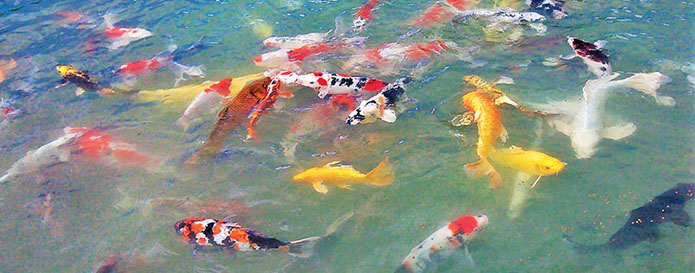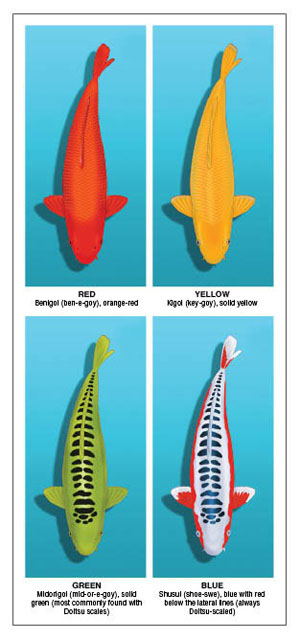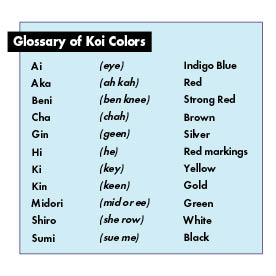
The pond build is complete! Water parameters are in check, and oxygen levels are adequate. Congratulations — you’ve created the ideal pond environment for your customer. The next step is to introduce koi into the pond because, after all, koi are the highlight of the water garden experience. They really are living jewels.
Just like gemstones, koi come in many colors. Some pond owners want only one color of fish in their pond. They love the aesthetically perfect image that monochromatic, single-colored fish provide. A pond that has just one variety of koi, such as Platinum Ogon (solid-white, metallic koi) is very striking. Other pond owners prefer a full color palette, desiring every color of the rainbow in their backyard water feature.
Deciding which koi colors look best in a body of water is solely up to the owner. Each pond is unique, and every koi is unique as well. No selection is right, and no selection is wrong. The most important factor to consider is to obtain beautiful and healthy koi for your customer’s pond.
When we look at a rainbow in the sky, we see a blend of colors: red, yellow, green and blue. Some koi variety names incorporate the Japanese word for a particular color, plus goi, which means carp. One example is the solid, nonmetallic red koi called Benigoi. Beni is the word for the color red. Nonmetallic yellow koi are Kigoi — ki means yellow. And green koi, which are quite rare, are Midorigoi. Midori — you guessed it — is the term for the color green.
There are significantly more varieties, types and colors of koi than those mentioned here. You can read about many more on the Kloubec Koi Farm website: www.kloubeckoi.com/ellens-koi-education/.
Yamabuki Ogon: A “Pot-o-Gold”
 Yamabuki Ogon means “yellow-gold” in Japanese. This variety is favored by many koi hobbyists for its brilliant golden-metallic skin with luster. This gentle variety can grow quite large and usually has a well-rounded, voluminous shape, producing an imposing presence in the pond. It should be blemish-free and have a consistent yellow color from nose to tail. A solid-colored metallic koi, the Yamabuki Ogon is easily visible even in pond water with less-than-desirable clarity. Often times, Yamabuki can be easily trained to eat from the hand of its owner, just like the nonmetallic yellow Kigoi.
Yamabuki Ogon means “yellow-gold” in Japanese. This variety is favored by many koi hobbyists for its brilliant golden-metallic skin with luster. This gentle variety can grow quite large and usually has a well-rounded, voluminous shape, producing an imposing presence in the pond. It should be blemish-free and have a consistent yellow color from nose to tail. A solid-colored metallic koi, the Yamabuki Ogon is easily visible even in pond water with less-than-desirable clarity. Often times, Yamabuki can be easily trained to eat from the hand of its owner, just like the nonmetallic yellow Kigoi.
From Drab to Fab
Approximately 1,000 years ago, the ordinary, common black carp was raised by farmers as a food source in Europe, Japan, China and Korea. The fish were plain in color and known as Magoi. These brown or black, drab-colored carp were depicted in many works of art and pottery in ancient times. The transformation of Magoi into our cherished living jewels began in the 1800s. Natural mutations occurred in the offspring, and a few fish emerged displaying additional pigment — mainly spots of red color. The rice farmers separated those rare specimens with irregularities and began producing colored carp.
The bland, common carp, Cyprinus carpio, has undergone countless transformations over many years of selective breeding to become the fabulously colored koi of today. Our finned friends that are kept for personal enjoyment and hobby were painstakingly bred and nurtured hundreds of years ago. Those dedicated Japanese farmers became the first koi breeders.
 In the early 1900s, the innovative breeders in Japan crossed a German carp with their highly-prized colored carp. Those breeding efforts resulted in early versions of the Doitsu (scaleless) types we are familiar with these days. Other breeding methods and the introduction of different fish have produced multiple-colored koi and variations such as metallic skin (Ogon), ginrin scales (sparkly diamond) and the long, graceful, exaggerated fins of the Hirenaga (butterfly koi).
In the early 1900s, the innovative breeders in Japan crossed a German carp with their highly-prized colored carp. Those breeding efforts resulted in early versions of the Doitsu (scaleless) types we are familiar with these days. Other breeding methods and the introduction of different fish have produced multiple-colored koi and variations such as metallic skin (Ogon), ginrin scales (sparkly diamond) and the long, graceful, exaggerated fins of the Hirenaga (butterfly koi).
We are thankful for the tireless and devoted efforts of the early Asian koi breeders of yesteryear. Without their foresight, the common black carp might not have evolved into the beautiful, colorful gems of today. Additionally, we owe the success of the koi industry to these insightful breeders. If not for their intrigue and commitment, keeping a piece of the rainbow in our backyards might have never been possible.


